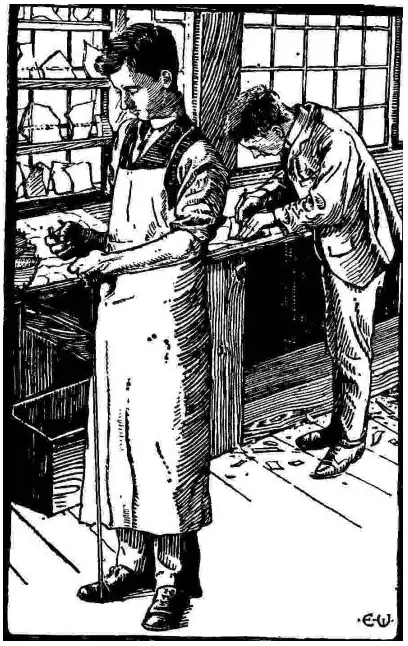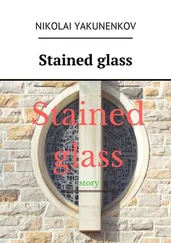Christopher Whall - Stained Glass Work - A text-book for students and workers in glass
Здесь есть возможность читать онлайн «Christopher Whall - Stained Glass Work - A text-book for students and workers in glass» — ознакомительный отрывок электронной книги совершенно бесплатно, а после прочтения отрывка купить полную версию. В некоторых случаях можно слушать аудио, скачать через торрент в формате fb2 и присутствует краткое содержание. Жанр: foreign_antique, foreign_home, visual_arts, на английском языке. Описание произведения, (предисловие) а так же отзывы посетителей доступны на портале библиотеки ЛибКат.
- Название:Stained Glass Work: A text-book for students and workers in glass
- Автор:
- Жанр:
- Год:неизвестен
- ISBN:нет данных
- Рейтинг книги:3 / 5. Голосов: 1
-
Избранное:Добавить в избранное
- Отзывы:
-
Ваша оценка:
- 60
- 1
- 2
- 3
- 4
- 5
Stained Glass Work: A text-book for students and workers in glass: краткое содержание, описание и аннотация
Предлагаем к чтению аннотацию, описание, краткое содержание или предисловие (зависит от того, что написал сам автор книги «Stained Glass Work: A text-book for students and workers in glass»). Если вы не нашли необходимую информацию о книге — напишите в комментариях, мы постараемся отыскать её.
Stained Glass Work: A text-book for students and workers in glass — читать онлайн ознакомительный отрывок
Ниже представлен текст книги, разбитый по страницам. Система сохранения места последней прочитанной страницы, позволяет с удобством читать онлайн бесплатно книгу «Stained Glass Work: A text-book for students and workers in glass», без необходимости каждый раз заново искать на чём Вы остановились. Поставьте закладку, и сможете в любой момент перейти на страницу, на которой закончили чтение.
Интервал:
Закладка:
Christopher Whall
Stained Glass Work: A text-book for students and workers in glass
" … And remembering these, trust Pindar for the truth of his saying, that to the cunning workman—(and let me solemnly enforce the words by adding, that to him only)—knowledge comes undeceitful ."
—Ruskin ("Aratra Pentelici")." 'Very cool of Tom,' as East thought but didn't say, 'seeing as how he only came out of Egypt himself last night at bed-time.' "
—("Tom Brown's Schooldays").To his Pupils and Assistants, who, if they have learned as much from him as he has from them, have spent their time profitably; and who, if they have enjoyed learning as much as he has teaching, have spent it happily; this little book is Dedicated by their Affectionate Master and Servant,
THE AUTHOR.
EDITOR'S PREFACE
In issuing these volumes of a series of Handbooks on the Artistic Crafts, it will be well to state what are our general aims.
In the first place, we wish to provide trustworthy text-books of workshop practice, from the points of view of experts who have critically examined the methods current in the shops, and putting aside up a standard of quality in the crafts which are more especially associated with design. Secondly, in doing this, we hope to treat design itself as an essential part of good workmanship. During the last century most of the arts, save painting and sculpture of an academic kind, were little considered, and there was a tendency to look on "design" as a mere matter of appearance . Such "ornamentation" as there was was usually obtained by following in a mechanical way a drawing provided by an artist who often knew little of the technical processes involved in production. With the critical attention given to the crafts by Ruskin and Morris, it came to be seen that it was impossible to detach design from craft in this way, and that, in the widest sense, true design is an inseparable element of good quality, involving as it does the selection of good and suitable material, contrivance for special purpose, expert workmanship, proper finish, and so on, far more than mere ornament, and indeed, that ornamentation itself was rather an exuberance of fine workmanship than a matter of merely abstract lines. Workmanship when separated by too wide a gulf from fresh thought—that is, from design—inevitably decays, and, on the other hand, ornamentation, divorced from workmanship, is necessarily unreal, and quickly falls into affectation. Proper ornamentation may be defined as a language addressed to the eye; it is pleasant thought expressed in the speech of the tool.
In the third place, we would have this series put artistic craftsmanship before people as furnishing reasonable occupations for those who would gain a livelihood. Although within the bounds of academic art, the competition, of its kind, is so acute that only a very few per cent. can fairly hope to succeed as painters and sculptors; yet, as artistic craftsmen, there is every probability that nearly every one who would pass through a sufficient period of apprenticeship to workmanship and design would reach a measure of success.
In the blending of handwork and thought in such arts as we propose to deal with, happy careers may be found as far removed from the dreary routine of hack labour as from the terrible uncertainty of academic art. It is desirable in every way that men of good education should be brought back into the productive crafts: there are more than enough of us "in the city," and it is probable that more consideration will be given in this century than in the last to Design and Workmanship.
Our last volume dealt with one of the branches of sculpture, the present treats of one of the chief forms of painting. Glass-painting has been, and is capable of again becoming, one of the most noble forms of Art. Because of its subjection to strict conditions, and its special glory of illuminated colour, it holds a supreme position in its association with architecture, a position higher than any other art, except, perhaps, mosaic and sculpture.
The conditions and aptitudes of the Art are most suggestively discussed in the present volume by one who is not only an artist, but also a master craftsman. The great question of colour has been here opened up for the first time in our series, and it is well that it should be so, in connection with this, the pre-eminent colour-art.
Windows of coloured glass were used by the Romans. The thick lattices found in Arab art, in which brightly-coloured morsels of glass are set, and upon which the idea of the jewelled windows in the story of Aladdin is doubtless based, are Eastern off-shoots from this root.
Painting in line and shade on glass was probably invented in the West not later than the year 1100, and there are in France many examples, at Chartres, Le Mans, and other places, which date back to the middle of the twelfth century.
Theophilus, the twelfth-century writer on Art, tells us that the French glass was the most famous. In England the first notice of stained glass is in connection with Bishop Hugh's work at Durham, of which we are told that around the altar he placed several glazed windows remarkable for the beauty of the figures which they contained; this was about 1175.
In the Fabric Accounts of our national monuments many interesting facts as to mediæval stained glass are preserved. The accounts of the building of St. Stephen's Chapel, in the middle of the fourteenth century, make known to us the procedure of the mediæval craftsmen. We find in these first a workman preparing white boards, and then the master glazier drawing the cartoons on the whitened boards, and many other details as to customs, prices, and wages.
There is not much old glass to be studied in London, but in the museum at South Kensington there are specimens of some of the principal varieties. These are to be found in the Furniture corridor and the corridor which leads from it. Close by a fine series of English coats of arms of the fourteenth century, which are excellent examples of Heraldry, is placed a fragment of a broad border probably of late twelfth-century work. The thirteenth century is represented by a remarkable collection, mostly from the Ste. Chapelle in Paris and executed about 1248. The most striking of these remnants show a series of Kings seated amidst bold scrolls of foliage, being parts of a Jesse Tree, the narrower strips, in which are Prophets, were placed to the right and left of the Kings, and all three made up the width of one light in the original window. The deep brilliant colour, the small pieces of glass used, and the rich backgrounds are all characteristic of mid-thirteenth-century glazing. Of early fifteenth-century workmanship are the large single figures standing under canopies, and these are good examples of English glass of this time. They were removed from Winchester College Chapel about 1825 by the process known as restoration.
W. R. LETHABY.January 1905.
AUTHOR'S PREFACE
The author must be permitted to explain that he undertook his task with some reluctance, and to say a word by way of explaining his position.
I have always held that no art can be taught by books, and that an artist's best way of teaching is directly and personally to his own pupils, and maintained these things stubbornly and for long to those who wished this book written. But I have such respect for the good judgment of those who have, during the last eight years, worked in the teaching side of the art and craft movement, and, in furtherance of its objects, have commenced this series of handbooks, and such a belief in the movement, of which these persons and circumstances form a part, that I felt bound to yield on the condition of saying just what I liked in my own way, and addressing myself only to students, speaking as I would speak to a class or at the bench, careless of the general reader.
Читать дальшеИнтервал:
Закладка:
Похожие книги на «Stained Glass Work: A text-book for students and workers in glass»
Представляем Вашему вниманию похожие книги на «Stained Glass Work: A text-book for students and workers in glass» списком для выбора. Мы отобрали схожую по названию и смыслу литературу в надежде предоставить читателям больше вариантов отыскать новые, интересные, ещё непрочитанные произведения.
Обсуждение, отзывы о книге «Stained Glass Work: A text-book for students and workers in glass» и просто собственные мнения читателей. Оставьте ваши комментарии, напишите, что Вы думаете о произведении, его смысле или главных героях. Укажите что конкретно понравилось, а что нет, и почему Вы так считаете.












